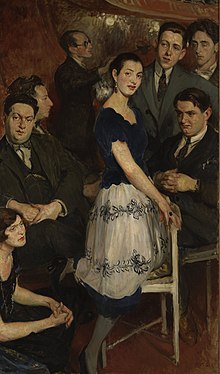Groupe des Six

The Groupe des Six or Les Six for short was a rather loose association of six French composers (five men and one woman).
Belonged to the group
- Georges Auric (1899-1983)
- Louis Durey (1888–1979)
- Arthur Honegger (1892–1955)
- Darius Milhaud (1892–1974)
- Francis Poulenc (1899–1963)
- Germaine Tailleferre (1892-1983)
This group initially formed around their musical mentor, the Parisian composer Erik Satie , who introduced four members to the Théâtre du Vieux-Colombier as “les nouveaux jeunes”. From 1918 the writer Jean Cocteau became its spokesman. The name, an allusion to the Russian group of five , they received in 1920 through a newspaper article by the group's close critic and composer Henri Collet .
The members were less connected by an aesthetic program than by a common rejection of romantic (especially Wagnerian ) music, the turning away from Claude Debussy's musical impressionism and turning to contemporary forms of popular music , e.g. B. Jazz , variety and circus music. Some of her works can be assigned to neoclassicism .
The group as a productive unit only existed for the first few years in the 1920s, after which each composer pursued his own development and what remained was a kind of circle of friends.
Joint works
While it was not the group's stated goal to collaborate on compositions, there have been five opportunities within 32 years in which at least some of the group members have collaborated. Only once were all six involved and sometimes composers outside the group took part. Auric and Poulenc were involved in each collaboration, Milhaud in four, Honegger and Tailleferre in three, Durey in one.
- L'Album des Six
- “Prelude” (December 22, 1919) - Auric
- “Romance sans paroles”, op. 21 (August 1919) - Durey
- "Sarabande", H 26 (January 1920) - Honegger
- "Mazurka" (1914) - Milhaud
- “Valse en ut”, FP 17 (July 1919) - Poulenc
- "Pastorale" (September 4, 1919) - Tailleferre
- Les Mariés de la Tour Eiffel (The Wedding on the Eiffel Tower), ballet based on a text by Jean Cocteau; 1921
- "Overture" Le 14-Juillet "" - Auric
- “Marche nuptiale” - Milhaud
- “Discours du Général” - Poulenc
- “La Baigneuse de Trouville” - Poulenc
- “La Fugue du massacre” - Milhaud
- "Valse des dépêches" - Tailleferre
- “Marche funèbre” - Honegger
- "Quadrille" - Waistferre
- "Trois ritournelles" - Auric
- "Sortie de la noce" - Milhaud
- L'éventail de Jeanne , Children's Ballet, 1927, by Auric, Milhaud and Poulenc, and seven other composers.
- "Fanfare" - Maurice Ravel
- “Marche” - Pierre-Octave Ferroud
- "Valse" - Jacques Ibert
- "Canarie" - Alexis Roland-Manuel
- "Bourrée" - Marcel Delannoy
- "Sarabande" - Albert Roussel
- "Polka" - Milhaud
- "Pastourelle" - Poulenc
- "Rondeau" - Auric
- Final: "Kermesse-Valse" - Florent Schmitt
- Mouvements du coeur , 1949, song cycle for baritone or bass and piano commemorating the 100th anniversary of the death of Frédéric Chopin ; by Auric, Milhaud and Poulenc, as well as Jean Françaix , Léo Preger and Henri Sauguet .
- La guirlande de Campra , 1952, orchestral work on motifs from André Campra's opera Camille (1717); Collaboration by Auric, Honegger, Poulenc, Tailleferre and three others.
- "Toccata" - Honegger
- “Sarabande et farandole” - Jean-Yves Daniel-Lesur
- "Canarie" - Alexis Roland-Manuel
- "Sarabande" - Waistleferre
- “Matelote provençale” - Poulenc
- "Variation" - Henri Sauguet
- "Écossaise" - Auric
Web links
- Stéphane Villemin: "XXth Century - Les Six , Satie, and Cocteau" , September 1, 2000 (French / English )
Individual evidence
- ↑ Hans Heinz Stuckenschmidt : "Eric Satie", in: Creator of New Music , DTV Muenchen 1962, p. 36.